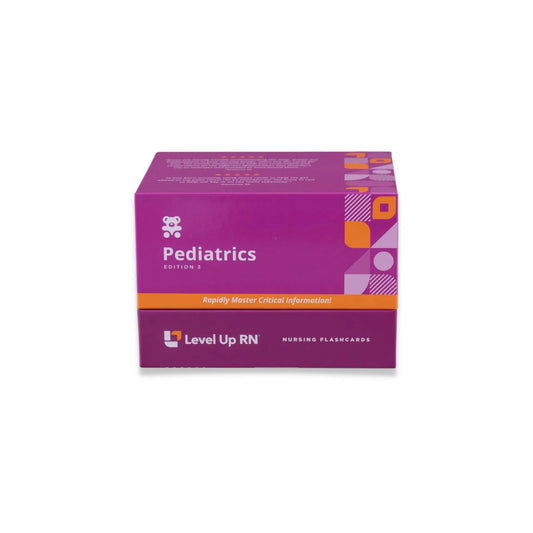In this video and article, we cover two important alterations in pediatric cardiovascular health: heart failure and hypoxemia.
This series follows along with our Pediatric Nursing Flashcards, which are intended to help nurses and nursing students learn and retain information about caring for pediatric patients. The flashcards are a clear, complete study tool and a helpful reference for practicing RNs, PNs, and other medical professionals.
 When you see this Cool Chicken, that indicates one of Cathy's silly mnemonics to help you remember. The Cool Chicken hints in these articles are just a taste of what's available across our Level Up RN Flashcards for nursing students!
When you see this Cool Chicken, that indicates one of Cathy's silly mnemonics to help you remember. The Cool Chicken hints in these articles are just a taste of what's available across our Level Up RN Flashcards for nursing students!
Pediatric Heart Failure
Heart failure is the inability of the heart muscle to adequately supply blood to meet the body's needs, because of volume overload on the heart muscle and/or pump failure. This may be due to a congenital heart defect, cardiomyopathy (disease of the heart muscle), or another cardiac abnormality. Heart failure results in a decreased cardiac output.
Please note this article focuses on Heart Failure as part of Pediatric Nursing. This is a pediatric alteration in health you will need to know about for your Pediatrics exams in nursing school. In nursing school, you also need to learn about heart failure in adults for your Medical-Surgical exams, which we've covered here: Med-Surg - Cardiovascular System, part 8: Heart Failure.
Studying both Pediatrics and Medical-Surgical in nursing school? We recommend The Ultimate Nursing School Survival Kit - Flashcards or the Level Up RN Membership.
Signs and symptoms
General signs and symptoms of pediatric heart failure can include poor feeding, tachycardia, activity intolerance, pallor, weak pulses, as well as cardiomegaly (enlargement of the heart — cardio = heart, mega = large) as a compensatory measure.
Differences between left and right-sided pediatric heart failure
Signs and symptoms of left-sided heart failure include tachypnea, dyspnea, nasal flaring, retractions, and wheezing.
Signs and symptoms of right-sided heart failure can include peripheral edema, ascites, hepatomegaly (enlargement of the liver, and jugular vein distension. Right-sided heart failure will cause systemic congestion.
Left-sided heart failure primarily affects the lungs, and right-sided heart failure affects the rest of the body. Why? Well, think about the expected direction of blood flow:
- Blood is in the body,
- Then it flows into the right side of the heart,
- Then it flows to the lungs,
- Then to the left side of the heart,
- And then out to the body.
We expect blood to flow in order: 1, 2, 3, 4, 5. If a step fails, then the next step doesn't happen as expected and the blood can move in a backward direction.
So if the left side of the heart is not functioning correctly, blood will fail to keep flowing in the expected direction into the body and instead flow backwards into the lungs. So instead of 1, 2, 3, 4, 5, you get 1, 2, 3, 4 (failure), 3.
If the right side of the heart is not functioning correctly, that blood will fail to keep flowing in the expected direction into the lungs and instead flow backwards into the body which can cause systemic congestion. So instead of 1, 2, 3, 4, 5, you get 1, 2 (failure), 1.
 Left affects the Lungs.
Left affects the Lungs.
 Right affects the Rest of the body.
Right affects the Rest of the body.
Labs
The lab values you may see with pediatric heart failure include an elevated hBNP level.
hBNP stands for Human B-type Natriuretic Peptides and is a hormone released by the heart in response to stretching of the heart muscle. In heart failure, you have fluid volume overload on the heart, which results in stretching of the heart muscle, which leads to elevated hBNP.
Diagnosis
Diagnostic tools that are helpful in the diagnosis of pediatric heart failure include an EKG, as well as a chest x-ray.
Treatment
Treatment for pediatric heart failure includes medications like digoxin, diuretics, beta blockers, and ACE inhibitors.
Digoxin is a key medication used to improve contractility of the heart. Cardiac glycosides inhibit cell membranes from pumping out sodium, which increases sodium in the cells, allowing more calcium to build. When the calcium is released, the heart contractions are stronger, which increases the total blood pumped with each heartbeat (cardiac output). Digoxin, which is a cardiac glycoside, slows down the heart rate and helps the heart's contractions be more effective and efficient.
A diuretic like furosemide can reduce fluid volume overload on the heart and also reduce edema (swelling due to excess fluid).
Beta-1 blockers include metoprolol and atenolol. Non-selective beta-blockers include propranolol, labetalol, and carvedilol. Beta blockers help to block the effects of epinephrine (adrenaline), which causes the heart to slow down and lowers blood pressure, both of which make it easier for the heart to pump blood
ACE inhibitors like captopril and lisinopril dilate the blood vessels and lower blood pressure, which makes it easier for the heart to pump blood.
Nursing care
Nursing care for pediatric heart failure includes feeding adjustments, activity adjustments, monitoring before digoxin administration, and monitoring for digoxin toxicity.
Remember that one of the symptoms of pediatric heart failure is poor feeding. Nursing care related to feeding include making sure the child is sitting upright when eating so the food goes down easier, and if a child is using a bottle, choosing a bottle nipple with an enlarged opening, which helps decrease the amount of energy required by the child when they're feeding. High-calorie formula might also be needed to help supplement a child's calorie intake.
Remember that one of the symptoms of pediatric heart failure is activity intolerance—the inability to perform or endure activity. So nursing care to assist with this includes providing frequent rest periods.
When administering digoxin, take the child's pulse before administration. Digoxin should NOT be administered for a pulse rate under 90 bpm for infants or under 70 bpm for older children—or per orders. Digoxin slows the heart, so slowing the heart rate when it is already low could be very dangerous.
Digoxin toxicity
The nurse should also monitor a pediatric heart failure patient who is on digoxin for signs and symptoms of digoxin toxicity: nausea, vomiting, bradycardia (heart rate under 60 bpm), and dysrhythmias. Their serum digoxin levels should also be closely monitored. The therapeutic range for digoxin is typically between 0.8 and 2 ng/mL. If you’d like to learn more about this and other lab values, check out our lab value flashcards for nursing students.
Pediatric Hypoxemia
Hypoxemia is an inadequate oxygenation of the blood. Pediatric hypoxemia is when this occurs in a pediatric patient. Hypoxemia can lead to hypoxia, which is an inadequate oxygenation of the body's tissues.
To help you understand and remember the difference between hypoxemia and hypoxia, it can help to break down the medical terminology.
- Hypoxia = hypo (low/deficient) + oxia (related to oxygenation)
- Hypoxemia = hypo (low/deficient) + -oxi- (related to oxygenation) + -emia (related to blood)
The word parts in hypoxia may not help on their own, but if you know that -emia means blood, you can differentiate the two terms. For more help breaking down medical terminology to help you recognize words on your nursing exams, check out our Medical Terminology and Abbreviations - Nursing Flashcards.
Causes of pediatric hypoxemia include congenital heart defects, anemia, or pediatric respiratory disorders.
Many congenital heart defects cause unoxygenated blood to enter systemic circulation.
Please note this article focuses on hypoxemia as part of Pediatric Nursing. This is a pediatric alteration in health you will need to know about for your Pediatrics exams in nursing school. In nursing school, you also need to learn about hypoxemia in adults for your Medical-Surgical exams, which we've covered here: Med-Surg Respiratory System, part 3: Oxygen Delivery Devices, Hypoxemia/Hypoxia, Sleep Apnea.
Studying both Pediatrics and Medical-Surgical in nursing school? We recommend The Ultimate Nursing School Survival Kit - Flashcards or the Level Up RN Membership.
Signs and symptoms
Signs and symptoms of pediatric hypoxemia include cyanosis, tachypnea, dyspnea, clubbing (upside-down, spoon-shaped nails), and polycythemia.
Polycythemia is an elevation in red blood cells in response to hypoxemia. Red blood cells carry oxygen, so if the body is low on oxygen, it will compensate by increasing the amount of red blood cells it produces in order to obtain that oxygen.
Labs & Diagnosis
Diagnostic tools for pediatric hypoxemia include running an arterial blood gas (ABG) test and pulse oximetry.
An arterial blood gas (ABG) is a test run on an arterial blood sample which can provide information on a patient's acid-base balance and ventilation by measuring the amount of oxygen, carbon dioxide, and bicarbonate present in the blood. An ABG result will show decreased PaO₂ (partial pressure of oxygen) in patients with pediatric hypoxemia.
A patient with pediatric hypoxemia may also show a decreased oxygen saturation with pulse oximetry.
Treatment
Treatment for pediatric hypoxemia can include providing oxygen, morphine, and IV fluids.
Nursing care
Nursing care of a pediatric patient with hypoxemia can include placing the child in a knee-to-chest position to help improve blood flow to the lungs.


